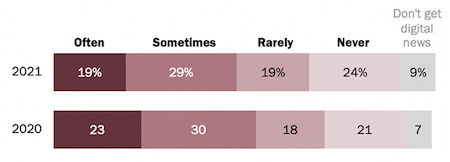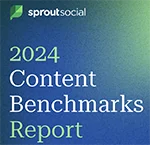Social media platforms have taken a lot of criticism in recent years for being hotbeds for disinformation and fake news. Perhaps as a result, a recent study released by the Pew Research Center finds that the number of Americans who get their news from social media has now declined.
Pew’s study analyzed Americans’ use habits of the 10 most popular social media sites. It found that, overall, less than half of Americans now get their news from social media sites at least sometimes (48 percent), a five-percent decline from a year ago (53 percent). 19 percent of Americans said they rarely get their news from social media sites, compared to 18 percent in 2020. 24 said they never get their news from social media platforms, compared to 21 percent last year.
 |
| Percentage of U.S. adults who say they get their news from social media sites (2021 vs. 2020). |
Facebook remains the giant of social media platforms, being used by two-thirds of all U.S. adults (66 percent). In terms of sheer numbers, Facebook also remains the social site where Americans regularly get their news the most. Yet the share of Americans who now regularly use the site for news has declined as well, from more than a third last year (36 percent) in 2020 to less than a third (31 percent) in 2021.
Video app TikTok, on the other hand, has seen a surge in the percentage of users who regularly turn to the site for news, rising from 22 percent last year to 29 percent in 2021.
The Pew report found that some social media sites are uniquely more “newsy” than others. For example, Twitter’s total audience remains relatively small, used by only about 23 percent of the U.S. adult population. However, among those who do use the site, more than half (55 percent) regularly use it as a news source. YouTube, on the other hand, while more popular (used by 72 percent of all U.S. adults), reveals a smaller portion of its users regularly turn to it for news (30 percent).
The Pew report surveyed 11,178 respondents drawn from the center’s American Trends Panel, a nationally representative list of randomly selected U.S. adults. The survey was conducted between July and August.


 What if companies could harness the fury of online outrage into a force for good? This is precisely where companies can start turning the trolls into brand champions.
What if companies could harness the fury of online outrage into a force for good? This is precisely where companies can start turning the trolls into brand champions. Audiences interacted with brand content far more often on Facebook and Instagram in 2023 than they did via X (formerly Twitter), according to a report that tracked engagement trends across different social networks.
Audiences interacted with brand content far more often on Facebook and Instagram in 2023 than they did via X (formerly Twitter), according to a report that tracked engagement trends across different social networks. Can public relations help counteract the dissension fostered by the power of digital platforms to spread hate, fear and confusion?
Can public relations help counteract the dissension fostered by the power of digital platforms to spread hate, fear and confusion? The number of Americans who get their news from TikTok has quadrupled in the last three years, according to a recent Pew Research Center report.
The number of Americans who get their news from TikTok has quadrupled in the last three years, according to a recent Pew Research Center report.


 Have a comment? Send it to
Have a comment? Send it to 
Sep. 22, 2021, by Joe Honick
It would be useful to exercise some independent critical thought with this set of findings. The very fact and dimensions of Facebook et al jut might color the thinking of millions as to just what they consider as "news." Often full out opinion from "influencers" might well create accepted facts even when not presented as "news." Murdoch and his bunch rely on that kind of thinking and have net profits for proof. Is that good? That's another question.